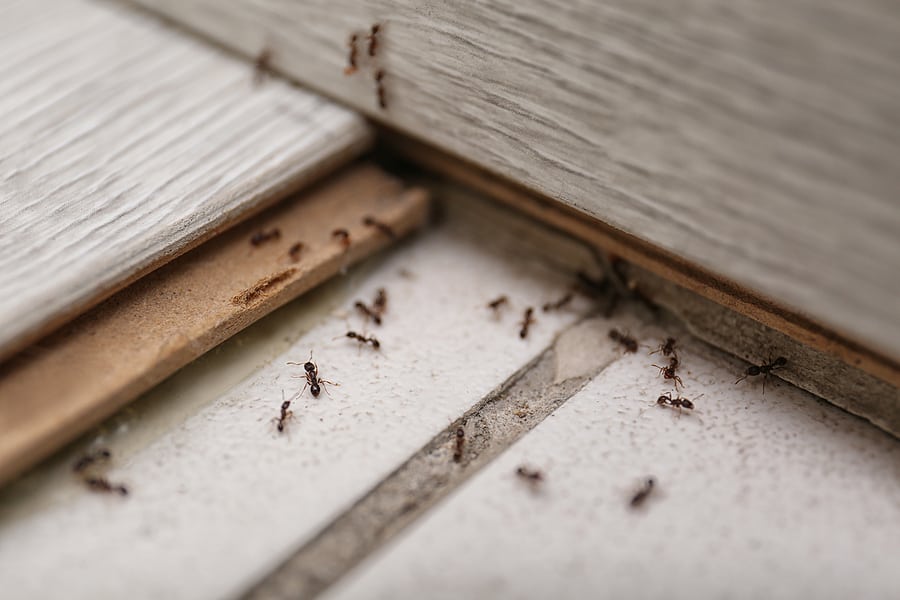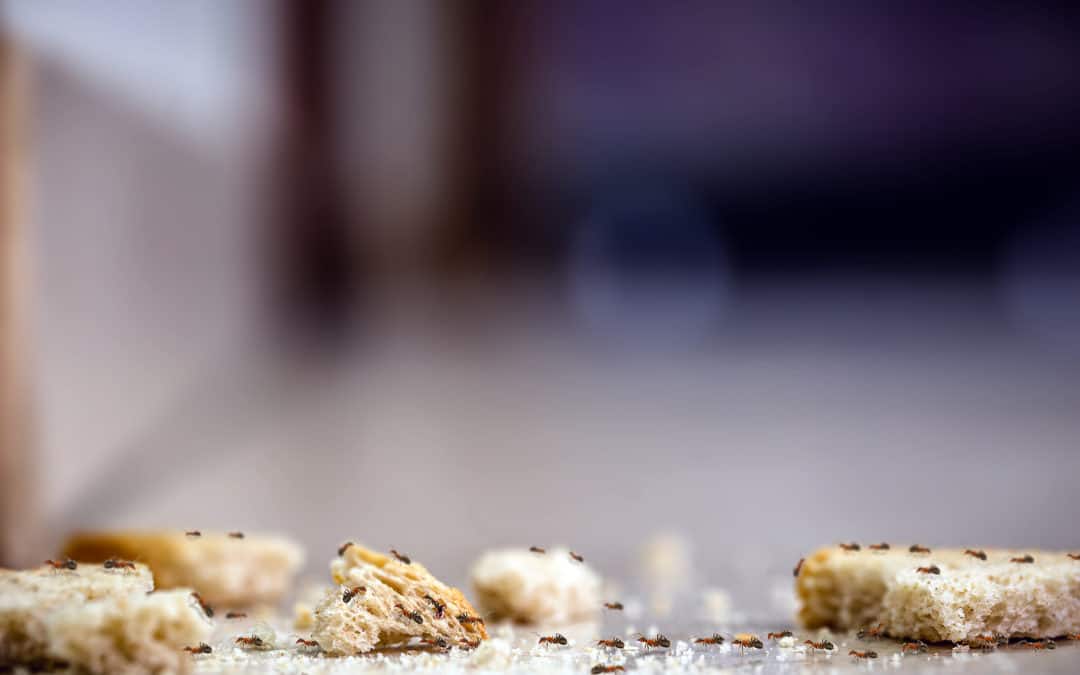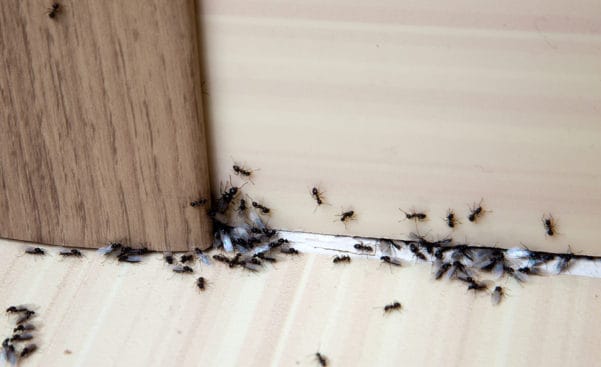READY TO GET STARTED?
REQUEST A FREE ESTIMATE
Fill out the form below or call (888) 466-7849 for a free, no-obligation estimate.

Little black ants are a common household pest usually seen in larger swarms during the warmer months of the year. These ants can be a huge nuisance, commonly infesting areas such as the bathroom and kitchen, searching for food and a place to nest. Once ants become a problem, it can be difficult to control them; but with some easy preventative measures, you’re less likely to encounter these pests!
Ants are always in search of food. Eliminating any food source that they have easy access to will be a major part of preventing them. After every meal, wipe down countertops and tables of any food crumbs or spills left behind. Don’t forget about your appliances either; ensure that your stove, microwave, and sink are also cleaned frequently. To prevent these pests from infesting your pantry, use sealed containers for any dry goods. Consider placing a bay leaf in canisters of dry food like flour to repel ants.
To survive, ants need water. Eliminating moisture throughout your home is key to ant prevention. Take some time to look around the interior and exterior of your home. If you notice any leaks, make sure you repair them immediately. Check your gutters often to make sure there are no clogs. Consider installing gutter guards to help prevent clogs. Additionally, make sure that the downspout is directing away from your foundation.
Being as little as they are, ants only need a small gap or hole to make their way inside. It’s essential to identify entry points and seal them properly to avoid infestation. Look around the interior and exterior of the home to look for these gaps. Popular places include areas where pipes and wires enter your home. Check your windows and door screens for any open holes and replace weatherstripping frequently.
Preventing ants can be difficult and feel impossible. If you’ve noticed an increase in ant activity around your home, consider contacting your local pest control provider. These professionals will complete a thorough and comprehensive treatment and control plan.

Ants are considered one of the most pesky nuisance pests homeowners must deal with. Ants will often enter homes during the winter, seeking water and food for survival. Now, with the weather warming, is the perfect time to start putting preventative measures in the most common places ants are found – the kitchen and the bathroom!
The kitchen is an ideal place for ants to infest. These pests are constantly searching for a water source, and the kitchen is the perfect place to find it. If the kitchen isn’t cleaned frequently and thoroughly, ants will invade quickly. Use these ant prevention tips to keep ants out of your kitchen:
The bathroom is highly vulnerable to an ant infestation as all the excess moisture will attract them. Carpenter ants will build their nests in damp areas, such as behind bathroom tiles or under sinks. To prevent ants from infesting your bathroom, take these preventative measures:
If you’ve noticed an influx of ants inside your home, consider calling your local pest control company. Trained service professionals will set you up with a prevention and treatment plan to help prevent these pests during peak ant season.

Ants are the most commonly reported pest in the country. While ants can be found just about anywhere in your home, the kitchen and bathroom are the most common rooms they are spotted in. Tiny black ants, also known as “nuisance ants,” or “odorous house ants,” invade your kitchen in search of food and water. While these nuisance pests are quite common, you may not know much about them. Here are 6 things you should know about these ants in your kitchen.
Ants don’t typically live indoors but instead establish colonies around your property. They will then make their way indoors in search of food and water. While odorous house ants can be quite a nuisance when they invade your kitchen, they don’t pose any significant risk to humans or their homes. These ants will feed on food and drink, especially sugary, sweet items and are attracted to crumbs and spills usually found in your kitchen. They don’t, however, bore through wood or cause structural damage to your home.
Ants in the kitchen are usually coming from somewhere and traveling to somewhere. If you follow their trail in both directions you can usually identify the food source that is attracting them. Cleaning up the spill or eliminating the food source will typically eliminate the ant problem. Ants can squeeze through openings the size of a pinhole, however, so while sealing up any entry points you find is a good idea, don’t be surprised if they make their way in again in the future.
Like most pests, ants are seasonal and incidences typically ebb and flow. Ants most commonly spike in the spring and summer when the weather warms up. This increase in temperature also increases their activity, driving them indoors in droves. They are also much more common following unseasonably warm winters. This is also swarming ant season which also increases their activity.
Ants are very social and have developed communication methods between each other. Ants can communicate through touch and through shared food. This communication helps them to avoid repellent remedies. Repellents like chalk that are placed in a line are often avoided by ants who just go around them. Spraying them with repellents will kill a few on contact but will typically just repel the rest, causing them to scatter but not die. A professional can treat ants with non-repellent products that they will take back to their colonies and disseminate among the entire population.
Different species of ants are attracted to different things and are treated in different ways. Proper identification is key to complete elimination. If you have an ant problem, try not to kill them all yourself because then your pest control company cannot identify them accurately. Best practice is to either leave them alone or try to collect samples by using tape to pick up a few and placing them in a Ziploc bag.
Ant control is difficult as they can get into your home through the tiniest of openings. Most ants are just a nuisance and can be gotten rid of by sealing your food and keeping spills and crumbs cleaned up. This does not, however, get rid of the colonies lurking outside your home waiting to get back in in search of food. If you suspect you have an ant problem or are having difficulty getting rid of an existing ant problem, contact a professional pest control company who can help properly identify the species of ant and provide the appropriate ant control techniques.
Can Termites Be Prevented or Is It Just Luck?
7 Tips For A Healthy Winter Lawn
Stop the Overwintering Pest Invasions